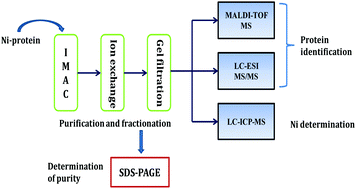当前位置:
X-MOL 学术
›
Metallomics
›
论文详情
Our official English website, www.x-mol.net, welcomes your feedback! (Note: you will need to create a separate account there.)
Analytical approaches for the characterization of nickel proteome
Metallomics ( IF 3.4 ) Pub Date : 2017-07-06 00:00:00 , DOI: 10.1039/c7mt00054e Javier Jiménez-Lamana 1, 2, 3, 4, 5 , Joanna Szpunar 1, 2, 3, 4, 5
Metallomics ( IF 3.4 ) Pub Date : 2017-07-06 00:00:00 , DOI: 10.1039/c7mt00054e Javier Jiménez-Lamana 1, 2, 3, 4, 5 , Joanna Szpunar 1, 2, 3, 4, 5
Affiliation

|
The use of nickel in modern industry and in consumer products implies some health problems for the human being. Nickel allergy and nickel carcinogenicity are well-known health effects related to human exposure to nickel, either during production of nickel-containing products or by direct contact with the final item. In this context, the study of nickel toxicity and nickel carcinogenicity involves the understanding of their molecular mechanisms and hence the characterization of the nickel-binding proteins in different biological samples. During the last 50 years, a broad range of analytical techniques, covering from the first chromatographic columns to the last generation mass spectrometers, have been used in order to fully characterize the nickel proteome. The aim of this review is to present a critical view of the different analytical approaches that have been applied for the purification, isolation, detection and identification of nickel-binding proteins. The different analytical techniques used are discussed from a critical point of view, highlighting advantages and limitations.
中文翻译:

镍蛋白质组表征的分析方法
镍在现代工业和消费产品中的使用对人类而言意味着一些健康问题。镍过敏和镍致癌性是与人体接触镍有关的众所周知的健康影响,无论是在生产含镍产品过程中还是直接与最终产品接触,都会对人体产生影响。在此背景下,对镍毒性和镍致癌性的研究涉及对它们的分子机理的理解,并因此涉及不同生物样品中镍结合蛋白的表征。在过去的50年中,为了全面表征镍蛋白质组,已使用了从第一色谱柱到最后一代质谱仪的广泛分析技术。这篇综述的目的是对已应用于镍结合蛋白的纯化,分离,检测和鉴定的不同分析方法提出一个批判性的见解。从批评的角度讨论了所使用的不同分析技术,突出了优点和局限性。
更新日期:2017-08-16
中文翻译:

镍蛋白质组表征的分析方法
镍在现代工业和消费产品中的使用对人类而言意味着一些健康问题。镍过敏和镍致癌性是与人体接触镍有关的众所周知的健康影响,无论是在生产含镍产品过程中还是直接与最终产品接触,都会对人体产生影响。在此背景下,对镍毒性和镍致癌性的研究涉及对它们的分子机理的理解,并因此涉及不同生物样品中镍结合蛋白的表征。在过去的50年中,为了全面表征镍蛋白质组,已使用了从第一色谱柱到最后一代质谱仪的广泛分析技术。这篇综述的目的是对已应用于镍结合蛋白的纯化,分离,检测和鉴定的不同分析方法提出一个批判性的见解。从批评的角度讨论了所使用的不同分析技术,突出了优点和局限性。



























 京公网安备 11010802027423号
京公网安备 11010802027423号